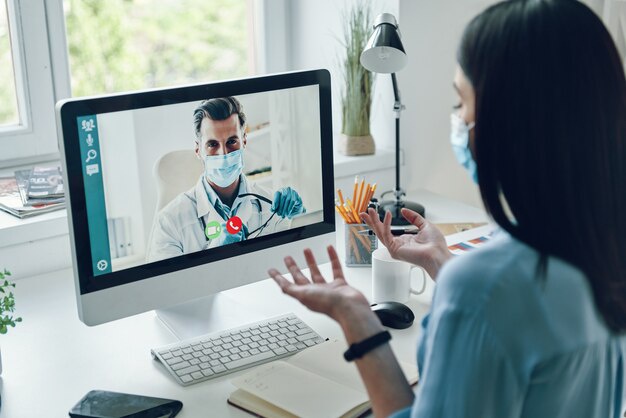In the ever-evolving landscape of healthcare, technology continues to play a pivotal role in transforming how we approach patient care. One such advancement that has gained significant attention is the development and implementation of Remote Patient Monitoring (RPM) systems.
What is a Remote Patient Monitoring System?
A Remote Patient Monitoring Platforms in the UAE is a technological solution designed to keep track of a patient's health data remotely. This includes monitoring vital signs, such as heart rate, blood pressure, and other relevant health metrics, without the need for the patient to be physically present in a healthcare facility. The primary aim is to provide continuous and real-time data to healthcare professionals, allowing for proactive intervention and timely adjustments to the patient's treatment plan.
How Does It Work?
The core of a Remote Patient Monitoring System lies in its ability to collect and transmit data from the patient to healthcare providers in a seamless manner. Patients use specialized devices, such as wearable sensors or smart home devices, to gather relevant health information. These devices are equipped with sensors that monitor specific health parameters.
The collected data is then transmitted securely to a centralized platform where healthcare professionals can access and analyze it. This real-time monitoring enables healthcare providers to detect any deviations from the patient's baseline and intervene promptly, preventing potential complications.
Key Components of Remote Patient Monitoring Platforms
-
Wearable Devices: These are typically small, lightweight devices that patients wear to monitor vital signs continuously. Examples include smartwatches, fitness trackers, or specific medical-grade devices.
-
Data Transmission: Reliable and secure communication channels are crucial for transmitting patient data. This often involves wireless technologies such as Bluetooth or cellular networks.
-
Centralized Monitoring Platform: The hub where healthcare professionals can view and analyze the collected data. This platform is designed to be user-friendly, allowing for efficient data interpretation and decision-making.
Benefits of Remote Patient Monitoring
-
Timely Intervention: Continuous monitoring enables healthcare providers to identify potential issues early, allowing for timely intervention and preventing the escalation of health problems.
-
Improved Patient Engagement: Patients actively participate in their own care by regularly monitoring their health. This engagement can lead to better adherence to treatment plans and lifestyle changes.
-
Reduced Healthcare Costs: By preventing hospital readmissions and emergency room visits, Remote Patient Monitoring can contribute to overall cost savings in the healthcare system.
-
Enhanced Quality of Care: Access to real-time data enables healthcare providers to make more informed decisions, leading to a higher quality of care for patients.
Challenges and Considerations
While Remote Patient Monitoring has shown immense promise, there are challenges to address. These include data security concerns, interoperability of devices and platforms, and the need for standardized protocols to ensure seamless integration into existing healthcare systems.
The Future of Remote Patient Monitoring
The future of Remote Patient Monitoring holds great promise as advancements in technology continue to reshape the healthcare landscape. As we look ahead, several trends and developments are poised to further enhance the effectiveness and accessibility of these platforms.
-
Integration with Artificial Intelligence (AI): The integration of AI algorithms into Remote Patient Monitoring systems is anticipated to significantly enhance the interpretation of health data. AI can analyze vast datasets, identify patterns, and provide valuable insights, aiding healthcare professionals in making more accurate and timely decisions.
-
Expansion of Telehealth Services: Remote Patient Monitoring is closely aligned with the broader trend of telehealth. As telehealth services continue to expand, the integration of Remote Patient Monitoring will likely become more seamless, providing a comprehensive virtual healthcare experience for patients.
-
Advancements in Wearable Technology: The ongoing evolution of wearable technology will play a crucial role in the widespread adoption of Remote Patient Monitoring. Future wearable devices are expected to be more sophisticated, offering a broader range of health monitoring capabilities while remaining user-friendly and unobtrusive.
-
Enhanced Connectivity and Interoperability: Efforts to standardize communication protocols and ensure interoperability between different devices and platforms will be pivotal for the widespread adoption of Remote Patient Monitoring. Improved connectivity will contribute to a more unified and efficient healthcare ecosystem.
-
Focus on Preventive Healthcare: Remote Patient Monitoring aligns with the shift towards preventive healthcare. By continuously monitoring health metrics, these platforms empower individuals and healthcare providers to take proactive measures to prevent the onset of chronic conditions and manage existing ones more effectively.
Conclusion
In conclusion, Remote Patient Monitoring Platforms represent a transformative force in healthcare, offering a dynamic and data-driven approach to patient care. As technology continues to advance, the integration of AI, the expansion of telehealth services, and improvements in wearable technology will further propel the efficacy and accessibility of these platforms.
While challenges remain, the ongoing collaboration between healthcare professionals, technology developers, and policymakers is crucial to addressing issues such as data security and interoperability. The ultimate goal is to create a healthcare ecosystem where Remote Patient Monitoring seamlessly integrates into routine patient care, contributing to improved outcomes, enhanced patient engagement, and a more sustainable healthcare model.
As we navigate the future of healthcare, Remote Patient Monitoring stands out as a beacon of innovation, demonstrating the potential to reshape how we monitor, manage, and enhance the well-being of individuals across the globe. With a focus on continuous improvement and collaboration, the journey towards a more connected and proactive healthcare future is well underway.


No comments yet